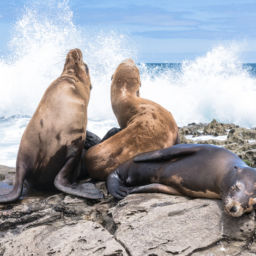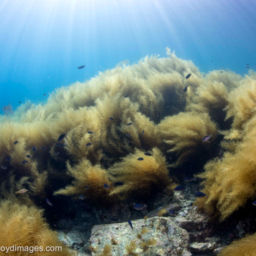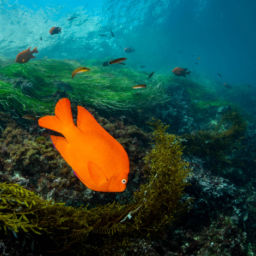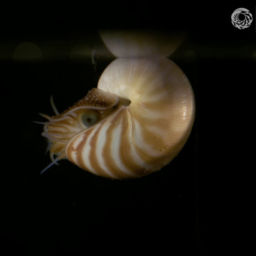The cold, nutrient-rich waters off the Southern California coast are host to a wide variety of habitats, each filled with an abundance of aquatic species. The profusion of life found here is such that not only can the region support numerous commercial fisheries, but also groups of Southern California marine mammals, ranging from seal colonies numbering fewer than 50 to pods of dolphins reaching into the thousands
Divers can see marine mammals during shore dives, boat dives, and even pelagic snorkeling adventures far offshore, depending on which species they are looking to find. Divers face varying opportunities depending on skill level, but it’s common to see most of these mammals without even setting foot in the ocean. In all cases, remember to read local interaction and conservation guidelines before approaching any marine mammal, always giving them ample space to feel comfortable.
Below you will find a list of the marine mammals you are most likely to find off the Southern California coast, along with a brief introduction to the species and some interesting facts that will help you along your way.
Southern California Marine Mammals
Pacific Harbor Seal (Phoca Vitulina)

- Harbor seals have spotted coats ranging from brown to silvery white and can weigh over 350 pounds. (158 kg) when fully grown.
- Unlike sea lions, seals do not have ear flaps and their rear flippers are short. Seals move on land by flopping on their bellies instead of walking on flippers, like sea lions.
- Harbor seals can dive to depths up to 1,500 feet (457 m) and remain submerged for up to 40 minutes at a time, although most dives are shorter, around five to seven minutes.
California Sea Lion (Zalophus Californianus)

- Typically brown in color, California sea lions have long flippers, allowing them to be very agile on land and adept climbers.
- These animals are very social and communicate through loud and often incessant barking.
- Adult male sea lions, or bulls, have a large, protruding bump on top of their head and can often weigh over 700 pounds (317 kg). Maintain a safe distance from large bulls, especially during mating and pupping seasons, as they can be protective of their colony.
Humpback Whale (Megaptera Novaeangliae)

- Adult humpbacks can vary between 40 to 50 feet (12 to 15 m) in length and are characterized by their black skin and unusually long pectoral flippers.
- These animals migrate over 8,000 miles (12,874 km)in a year, back and forth from their winter mating grounds. Some individuals travel along the California coast during this migration.
- The are often seen offshore displaying impressive acrobatics and breaches, such as the one pictured here.
Gray Whale (Eschrichtius robustus)

- Gray whales are easily identified by their immense size and grayish white mottled skin, which is attributed to crustaceans living on the skin of the whale.
- This whale will migrate over 10,000 miles (16,093 km) annually, one of the longest migrations of any mammal on this planet.
- They will travel very close to shore and are sometimes spotted by divers in Southern California kelp beds.
Blue Whale (Balaenoptera musculus)

- This is the largest mammal to have ever lived on Earth, reaching up to 100 feet (30 m) in length and weighing over 150 tons.
- Blue whales have a very streamlined body that is grayish-blue in color. Its broad, triangular tail can also be used for identification as the whale descends below the surface.
- Occasionally found off the California coast feeding on large aggregations of krill, these marine mammals can eat over six tons in a single day.
Common Bottlenose Dolphin (Tursiops truncates)

- The bottlenose dolphin is the largest of all beaked dolphins, and their habitat range spans most of the globe. They can be identified by their size and dark gray color.
- As with most dolphins, bottlenose dolphins are very social and can be seen in large pods off the Southern California coast.
- Divers will occasionally hear the clicking and whining of bottlenose dolphins using echolocation to communicate or hunt for prey.
Not pictured, but in the area:
Short-beaked common dolphin (Delphinus delphis)
- One of the most abundant dolphin species, these are primarily found in oceanic or offshore habitats in large numbers.
- Short-beaked common dolphins are medium-sized with dark-colored backs, white bellies and a grayish hourglass “saddle” on both sides.
- Ther are often found off the Southern California coast near underwater ridges or seamounts, where upwelling occurs, bringing their prey closer to the surface.
Pacific White-Sided Dolphin (Lagenorhynchus obliquidens)
- Males of this species can reach over 8 feet (2m) in length and are easily identified by their unique coloration. While their face and belly are white, the remainder of their body is dark gray, with a light gray patch and stripe going down both sides.
- Known for their energetic acrobatics, they can also be found riding the bow wake in front of vessels going at an appropriate speed.
- They form very close social groups and are rarely seen in groups smaller than 10 individuals. They occasionally form super-pods of over 300 individuals when food is abundant.
















